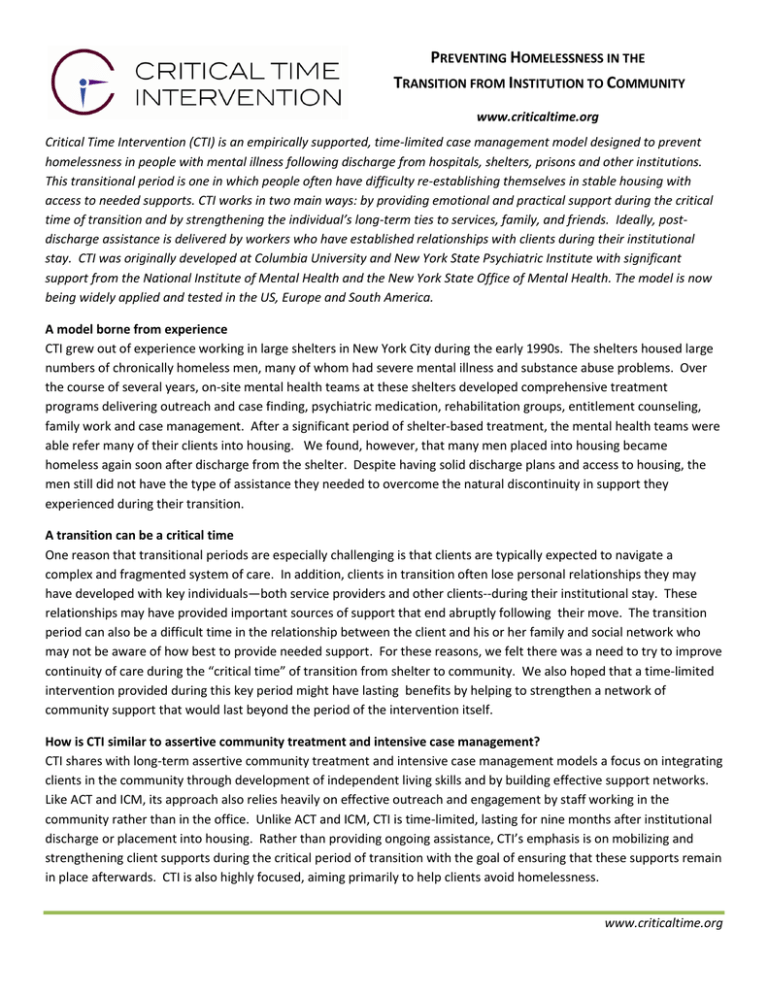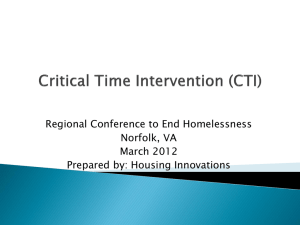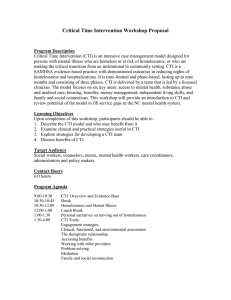www.criticaltime.org Critical Time Intervention (CTI) is an empirically
advertisement

PREVENTING HOMELESSNESS IN THE TRANSITION FROM INSTITUTION TO COMMUNITY www.criticaltime.org Critical Time Intervention (CTI) is an empirically supported, time-limited case management model designed to prevent homelessness in people with mental illness following discharge from hospitals, shelters, prisons and other institutions. This transitional period is one in which people often have difficulty re-establishing themselves in stable housing with access to needed supports. CTI works in two main ways: by providing emotional and practical support during the critical time of transition and by strengthening the individual’s long-term ties to services, family, and friends. Ideally, postdischarge assistance is delivered by workers who have established relationships with clients during their institutional stay. CTI was originally developed at Columbia University and New York State Psychiatric Institute with significant support from the National Institute of Mental Health and the New York State Office of Mental Health. The model is now being widely applied and tested in the US, Europe and South America. A model borne from experience CTI grew out of experience working in large shelters in New York City during the early 1990s. The shelters housed large numbers of chronically homeless men, many of whom had severe mental illness and substance abuse problems. Over the course of several years, on-site mental health teams at these shelters developed comprehensive treatment programs delivering outreach and case finding, psychiatric medication, rehabilitation groups, entitlement counseling, family work and case management. After a significant period of shelter-based treatment, the mental health teams were able refer many of their clients into housing. We found, however, that many men placed into housing became homeless again soon after discharge from the shelter. Despite having solid discharge plans and access to housing, the men still did not have the type of assistance they needed to overcome the natural discontinuity in support they experienced during their transition. A transition can be a critical time One reason that transitional periods are especially challenging is that clients are typically expected to navigate a complex and fragmented system of care. In addition, clients in transition often lose personal relationships they may have developed with key individuals—both service providers and other clients--during their institutional stay. These relationships may have provided important sources of support that end abruptly following their move. The transition period can also be a difficult time in the relationship between the client and his or her family and social network who may not be aware of how best to provide needed support. For these reasons, we felt there was a need to try to improve continuity of care during the “critical time” of transition from shelter to community. We also hoped that a time-limited intervention provided during this key period might have lasting benefits by helping to strengthen a network of community support that would last beyond the period of the intervention itself. How is CTI similar to assertive community treatment and intensive case management? CTI shares with long-term assertive community treatment and intensive case management models a focus on integrating clients in the community through development of independent living skills and by building effective support networks. Like ACT and ICM, its approach also relies heavily on effective outreach and engagement by staff working in the community rather than in the office. Unlike ACT and ICM, CTI is time-limited, lasting for nine months after institutional discharge or placement into housing. Rather than providing ongoing assistance, CTI’s emphasis is on mobilizing and strengthening client supports during the critical period of transition with the goal of ensuring that these supports remain in place afterwards. CTI is also highly focused, aiming primarily to help clients avoid homelessness. www.criticaltime.org The Critical Time Intervention Model CTI is carried out in three distinct phases spanning nine months as described below. Phase Transition Try-Out Transfer of Care Timing Months 1-3 Months 4-7 Months 8-9 Purpose Provide specialized support & implement transition plan Facilitate and test client’s problem-solving skills CTI worker makes home visits Accompanies clients to community providers Meets with caregivers Activities Substitutes for caregivers when necessary CTI worker observes operation of support network Helps to modify network as necessary Terminate CTI services with support network safely in place CTI worker reaffirms roles of support network members Develops and begins to set in motion plan for long-term goals (e.g. employment, education, family reunification). Holds party/meetings to symbolize transfer of care Gives support and advice to client and caregivers Mediates conflicts between client and caregivers Phase One: Transition to the Community focuses on providing intensive support and assessing the resources that exist for the transition of care to community providers. Ideally, the CTI worker has already begun to engage the client in a working relationship before he or she moves into the community. This is important because the worker will build on this relationship to effectively support the client following discharge. During the first few weeks following this move, the CTI worker maintains a high level of contact with the client, both through regular telephone calls and home visits. Clients are accompanied to appointments with selected community providers, such as mental health and medical clinics. The CTI worker “introduces” the client to his or her new providers in order to facilitate the development of a durable tie and encourages them to negotiate compromises when problems arise. The CTI worker also meets with key figures in the client’s residence. They discuss potential housing crises and try to identify ways to avoid them or possible coping strategies and resources, should a crisis occur. The CTI worker offers support to these persons while making it clear that he or she is prepared, when necessary, to mediate a compromise between them and the client. He or she brings together clients, family members and service providers to enhance communication and to detail proposed arrangements to ensure medication adherence, money management, or control of substance abuse. The CTI worker generally makes detailed arrangements in only the handful of areas that are seen as most critical for the community survival of that individual; it is important not to be overly ambitious. www.criticaltime.org Phase Two: Tryout is devoted to testing and adjusting the systems of support that were developed in phase one. By now, community providers will have assumed primary responsibility for the provision of support and services, and the CTI worker can focus on assessing whether the support system is functioning as planned. During this phase, the worker encourages the client and his or her supporters to handle problems on their own. The worker meets with the client less frequently, but maintains regular contact in order to observe how the plan is working and be ready to intervene when a crisis arises. In many cases, modification of the support system is required. Such “system adjustment” may be accomplished via a case conference or less formal meetings between the client and those involved in the support system. The CTI worker acts as a primary resource for all parties and assists them in creating a framework for resolving potential conflicts. For some clients, this period requires a renegotiation of treatment plans and a more active role for the CTI worker in implementing these plans. Phase Three: Transfer of Care focuses on completing the transfer of responsibility to community resources that will provide long-term support to the client. One way that CTI differs from services typically available to clients during transitional periods is that the transfer of care process is not abrupt; instead, it represents merely the endpoint of work occurring over the full nine months. Throughout the intervention, the CTI worker has gradually reduced his or her role in delivering direct services to the client. The worker’s main function in this phase is to ensure that the most significant members of the support system meet together and, along with the client, reach a consensus about the components of the ongoing system of support. Ideally, this occurs at least one month before the end of the intervention. This gradual process ensures that the termination of CTI is not seen by the client and the members of his or her support system as a sudden, potentially traumatic, loss. Evidence for Effectiveness CTI has been evaluated in several carefully designed studies. The first test of the model was a randomized trial1 that assessed the effectiveness of CTI in preventing homelessness among 96 homeless men with severe mental illness being placed into community housing from a large municipal shelter in Increased Likelihood of Remaining Housed in Men with Severe Mental Illness New York City. In this study, CTI Assigned to CTI Compared to Usual Services led to a significant reduction in post-discharge homelessness over 18 months. As shown, the effect lasted beyond the end of the nine-month period of active intervention, consistent with the idea that the intervention successfully enhanced community supports. An economic analysis2 found that the CTI group and the usual services group incurred almost identical average costs for acute care 1 Susser et al. (1997). Preventing recurrent homelessness among mentally ill men: a "critical time" intervention after discharge from a shelter. American Journal of Public Health, 87(2), 256-262. 2 Jones, K. et al. (2003). Cost-effectiveness of critical time intervention to reduce homelessness among persons with mental illness. Psychiatr Serv, 54(6), 884-890. www.criticaltime.org services, outpatient services, housing and shelter services, criminal justice services, and transfer income over the followup period. Since these costs were associated with a significantly reduced homelessness in the CTI group, we concluded that the intervention was cost-effective in comparison with usual care. A six-month version of the model was implemented at eight Department of Veterans’ Affairs medical centers throughout the US. In a quasi-experimental study, 278 homeless persons with severe mental illness were recruited and followed for one-year after discharge from inpatient psychiatric treatment, receiving standard case management services in the community. Following this, case managers were trained in the CTI model and a second group of 206 subjects were recruited and offered CTI. Controlling for baseline differences between cohorts, investigators found that the CTI cohort had on average 19% more days housed than did the first cohort over the one-year follow-up period3. Another recently completed study4 assessed the outcomes of 150 men and women with severe mental illness following discharge from state psychiatric hospitals in New York City. Using random assignment, half were offered CTI and half received standard discharge planning and follow-up care. Both groups were followed for 18 months. Subjects assigned to CTI were, on average, five times less likely to be homeless at the end of the study compared with subjects assigned to the usual services group. On the strength of the results of these studies, CTI has been added to the National Registry of Evidence-based Programs and Practices. Training & implementation support To respond to growing interest, the model development team has recently developed fidelity guidelines as well as a partnership with the Center for Urban Community Services, Inc., to deliver individualized training and implementation support to interested providers. In the near future, we expect to be able to provide web-based training and support which is currently being developed by the Center for Social Innovation with support from NIMH. Organizations that wish to learn more about in-person or web-based training should inquire via our website (www.criticaltime.org). Current and future directions The work described above focuses on how CTI has been employed to assist adults with severe mental illness in the transition from shelters and hospitals to housing in the community. However, we believe that there are a number of other such “critical times” at which the model may also be effectively deployed. For instance, CTI is now being applied with men and women being discharged from prisons, and with young adults leaving residential treatment facilities. CTI could also be useful in transitions that, while not involving institutional discharge, nevertheless pose significant challenges to sustaining continuity of needed supports such as persons with severe mental illness transitioning from more intensive to less intensive service models. Investigators working in the US, Europe and South America are currently carrying out work in these and other settings. To end with one note of caution; it is important to acknowledge that the CTI model relies heavily on mobilizing and coordinating existing housing, services and supports in the community. It stands to reason, therefore, that its effectiveness will be significantly mediated by the availability and quality of these resources. Particularly during this difficult economic period, the barriers to increasing and sustaining these supports will be considerable. his argues for the need to employ approaches such as CTI that have the potential to more effectively knit fragmented sources of aid into ongoing networks of community support for our most vulnerable fellow citizens. 3 Kasprow, W. J., & Rosenheck, R. A. (2007). Outcomes of critical time intervention case management of homeless veterans after psychiatric hospitalization. Psychiatr Serv, 58(7), 929-935. 4 Herman, D., (2009) CTI in the transition from hospital to community, unpublished data. www.criticaltime.org





